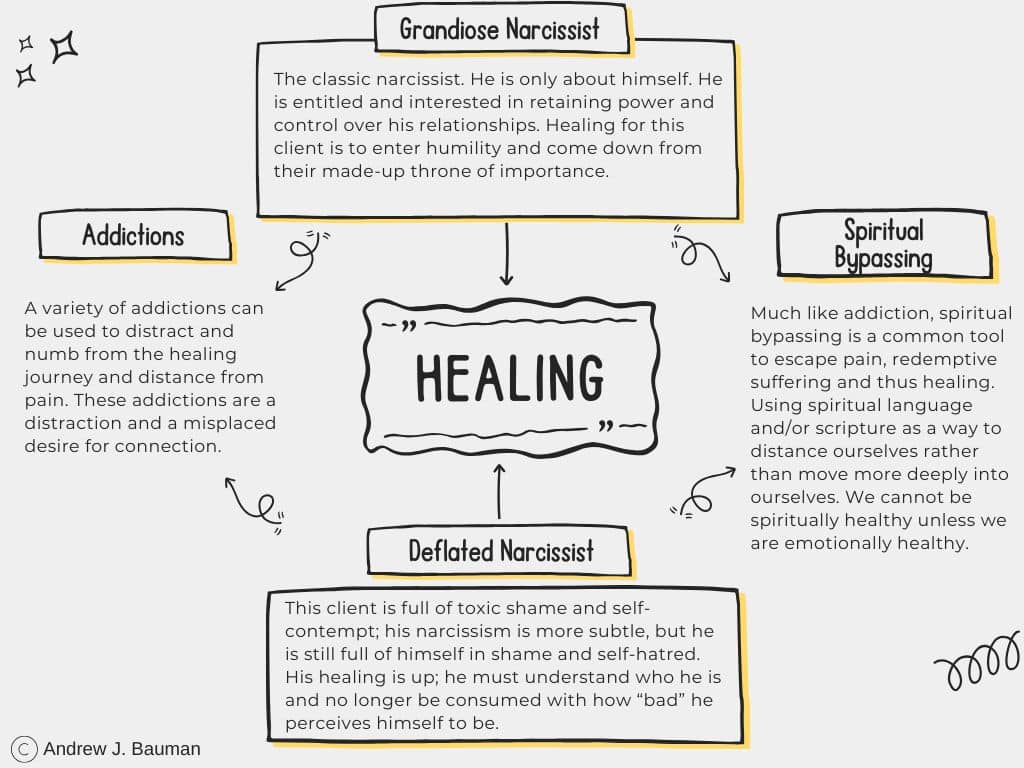“In the one-up, one-down world of men, there’s no place for ‘same as,’ and hence no platform for real intimacy. You’re either a winner or loser: dominator or dominated, grandiose or shame-filled. And you can’t be truly intimate from either the one-down (shame-filled) or the one-up (grandiose) position.” – Terry Real
When working with men who are struggling with deceptive sexuality (which is the act of hiding one’s sexual behaviors from their committed partner) and integrity abuse (a pattern of lying and taking advantage of your partner’s trust in you; compromising morals again and again), we must understand how we properly get to the goal of “healing” with this type of client. Two distinct types of men engage in deceptive sexuality and integrity abuse; the most common type of client comes from a “grandiose” place, referred to in the field as a narcissistic abuser. For this client who is acting from the one-up position, healing requires them to come “down” as they have put themselves above everyone else; they are the classic narcissist who is full of themselves, and must be on the higher side of power to feel okay emotionally and internally. This relational distance of being “above” keeps them from tasting genuine healing and repentance. These men can heal, but they must drink deeply from the cup of humility and enter their crucifixion for healing to begin to take root in their souls. This can be a long and arduous journey for the “grandiose” client, and the majority of the time, for this type of client, choosing the path towards liberation and redemption is too difficult to traverse, resulting in discontinuation of treatment and recovery.
Yet, there is a spectrum of abusers, and it is not a one-size-fits-all model for the healing journey. The other side of healing is in the form of moving “up” from the one-down position for the clients who present with a lot of shame and self-contempt. They still have a form of “narcissism,” but of a different flavor. I call this type of narcissist the “deflated narcissist”. The deflated narcissist is in a shame-based position, turning their contempt inward, towards self. Shame and self-contempt are often viewed as merely negative and something to avoid. Thus, many therapists try to mitigate it when it arises within a client. However, as therapists, we must learn to befriend and fully face shame and self-contempt, thereby utilizing it for the therapeutic benefit of our clients. Therapist and author Terry Real writes, “you can’t be truly intimate from either the one-down (shame-filled) or the one-up (grandiose) position.” Healing is in the middle (“same-as”), with a few potential distractions on the way (i.e., addictions, spiritual bypassing, to name a few). When working with shame-filled clients, healing involves moving beyond the position of being one-down. You must engage with shame in a way that helps them make peace with it by confronting the truth about who they are and how they perceive that their shame and self-hatred serve them.
This “deflated narcissist” position is still consumed with “self”, thoughts of “it’s all my fault”, “I am worse than everyone else”, or “I am uniquely screwed up”. For the “deflated narcissist,” he must learn that he is not uniquely bad or special, and must walk the healing path just like everyone else. He must tell the truth of who he actually is, rather than be consumed with the fantasy of how “bad” he is. This one-down position gives him an “out” to avoid actually doing the healing work, play small, and remain stuck as a “victim,” thereby continuing to escape responsibility for his own liberated life. He can make a villain out of himself or others and continue to play the role of “Eeyore” with his pessimism and doom and gloom outlook on his healing, and never require any “action” of transformation, and remain stuck in his own self-flagellation and perverse version of self-hatred masquerading as humility.
Toxic shame and self-contempt are key factors in the deflated position; these two are related to each other and serve a similar purpose of keeping the client away from intimacy and healing. Their core wounds remain unattended to as they are consumed with self, and our therapeutic approach must help bring them out of this alluring, indulgent trap.

As therapists, engaging the deflated narcissist is about finding the proper balance between truth, strength, and kindness. They will only listen to you if you bring potent truth to what you see, but also only if you bring a deep-centered strength with a softness in your eyes, so that they can see you are for them, and a fan of their liberation. (Side note: for female therapists who confront male narcissism in all its various forms, you first must address with your clients fundamental hatred of the feminine before meaningful transformation will ever take place for your client.)
For the deflated narcissist, they must hold a balance between their depravity and their glory. Meaning, if they are aware of their darkness and shadow, they will never become too “grandiose” because they are telling the truth about their wounded child and their adaptive adolescent, and they have a clearer understanding of their depravity. If they tell the truth about their glory and goodness, then they can never have too much self-contempt and/or shame because they are aware that they are an “image bearer of God” (Gen. 1:27), and that Christ lives in them (Romans 12:2). God resides in their body so to curse themselves is to curse God. I often encourage clients to try this experiment the next time they experience self-contempt: take their middle finger and point it toward the sky, and then, in a loud and audible voice, curse God, and see how that feels in their body. Clients often look at me with a puzzled and somewhat offended expression, saying, “I could never do that.” Yet, I remind them that they do it all the time, just with less honesty. Each time they participate in self-contempt, they “curse” the very God they claim to serve.
Whether you are coming from a one-up or one-down position in your healing journey, there are inevitable distractions along the way that sabotage our restoration. Two of the main ones I will address are addictions and spiritual bypassing.
Addictions- The Numbing of Desire
A variety of addictions can be used to distract and numb our pain and distance ourselves from the healing journey and what we most crave, intimacy and connection. This is true for all types of narcissism. Journalist Johann Hari in his TED talk entitled, “Everything You Think You Know About Addiction is Wrong,” said this profound statement, “The opposite of addiction is not sobriety, but connection.” These addictions are a distraction and a misplaced desire for connection. Addictions lower the risk of being rejected. Our clients long for genuine intimacy, but struggle to know the how-to of relationship building. Many men, due to socialization, have not adequately learned the steps to the dance of intimacy and are unsure how to move freely within an intimate, connected relationship. Addictions can take a variety of forms, but all result in the same outcome: further isolation and a magnification of who the client already is. Another common path that narcissists take to avoid responsibility and reaffirm entitlement is that of spiritual bypassing.
Spiritual Bypassing- A Spirit of Distraction
Spiritual bypassing is using spirituality to “bypass” difficult emotions rather than to enter them. We can’t be spiritually healthy unless we are emotionally healthy. Spiritual bypassing leads to greater anxiety and depression (Fox & Picciotto, 2019), while healthy spirituality leads to greater intimacy and contentment. An example of spiritual bypassing is when I lost my first son, Brave. We lost him 42 weeks and one day before he was to be induced. It was heartbreaking and tragic, and a part of me died when he died. You can read my wife’s and my account in our book “A Brave Lament” and experience the journey through our documentary film by the same name. Well-meaning friends would email and say things like, “I am sorry, and I know God has a plan.” One person wrote to me to tell me, “God told them that I would have another son.” These statements are not only not helpful, but can be downright cruel. We must not move too quickly to “resurrection” without first sitting in the death and being fully present with the devastation. I didn’t need easy answers or spiritual solutions that could not bring my son back. I needed people to weep with me. For the following year after our tragedy, I blogged online as if my life depended on it, because it did, I wrote to stay alive, to emotionally and spiritually function, and I needed people to be with me in the death and the mess of my own blood. I did not need people to distance me from my pain, but an invitation to feel it more fully, because it is only running into the grief that we can ever move beyond it.
A common example of spiritual bypassing within marriage is when a spouse brings a complaint to their partner and chooses to use spiritual bypassing rather than engaging in a difficult conversation. For example, Barb shares with her husband, “I really need more help around the house and feel like I have been carrying the burden of household chores all alone.” Troy’s immediate response is reactive and not reflective; he is defensive and “feels” attacked. Instead of acknowledging his defensiveness and taking a break, and taking responsibility for his own emotions, he fires back. “Well, work has been so stressful, and you don’t understand the pressure I am under, you will never get me”. (Notice how he quickly becomes the victim, and if Barb is not wise, she could fall into his manipulative trap.) Barb sees through his defensiveness and reactivity and says, “I am sorry that you are stressed at work, and have a lot of pressure on you, but that has nothing to do with the complaint that I brought you. If you have a complaint that you would like to bring up at a later time, I would be glad to hear from you and help support you. But now, I am asking for your support and helping me make a plan so that I do not feel as alone in doing the household chores.” Troy stops and takes a few deep breaths and tries a different approach. “I promise I will pray about this tonight and take it up with God and get back to you”. Barb knows if she starts yelling and cursing it would only reaffirm the narrative that she is the “crazy” wife and he is the level headed “spiritual leader” when in reality Troy is emotionally stunted and it is driving Barb to begin to despair that he will never change and learn to take responsibility for his behavior and his unaddressed wounds that are causing him to relate in such a young way.
In this example, Barb humbly invited Troy to get to know her and meet her in a vulnerable way; it was an invitation to be known and seen. Troy attempted multiple different ways to deflect, and it ended with the final blow to Barb’s vulnerable heart by spiritual bypassing. Troy used God to escape any type of responsibility and weaponized his prayer life against his wife’s complaint so that he did not have to engage further. In that moment, presence and understanding towards Barb are needed more than his escape through prayer. Don’t get me wrong, prayer is vital and effective, but in that moment, he was misusing the gift of prayer and weaponizing it against his wife. If Troy were going to enter into meditation and prayer, he would want it to be a prayer to increase his humility, brokenness, and conviction regarding the reordering of his priorities so that Barb isn’t so alone.
Given how we all can be led astray by distractions such as addictions and spiritual bypassing, it becomes crucial to define what true healing actually is.
What is Healing?
Healing from grandiose narcissism and deflated narcissism is a path of returning to what is most true, knowing that God is truth. Hence, the more we live in truth, the more we experience God. We can no longer inflate or deflate to hide ourselves, mask our addictions, spiritual bypass emotions, or attempt to numb our pain. As therapists, we can no longer allow narcissists off the hook and unchallenged due to fear of retribution and retaliation. If you are a therapist who isn’t confronting narcissism when you see it, then many times you are merely helping arm an abusive man with more mastery of therapeutic language and helping him become more advanced and nuanced in his abuse. Entitlement isn’t cured by passivity or cowardice, but rather by strong, kind, and authentic confrontation. The classic version of narcissism disguises deep insecurity with grandiosity. At the same time, the deflated narcissist hides behind deep levels of self-contempt and toxic shame, still centering himself but through the lens of victimhood. Both are strategies that prevent our clients from achieving healing and liberation, which we are all designed for.
Healing is the slow and sacred work of learning to grieve. Taking full responsibility for your shadow without turning toward self-hate. This is the path of courage and integrity, unlearning the lies, and beginning to live a life you can be proud of.






